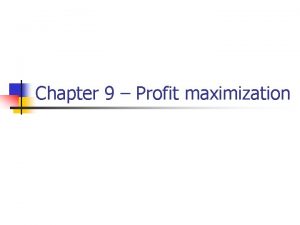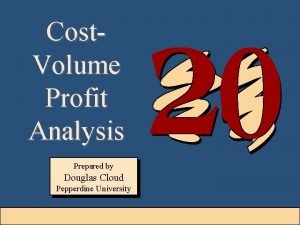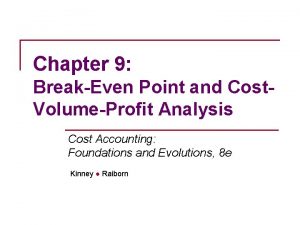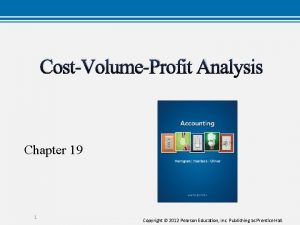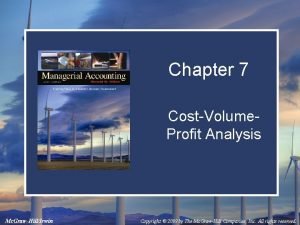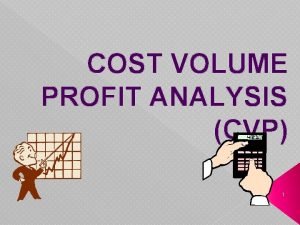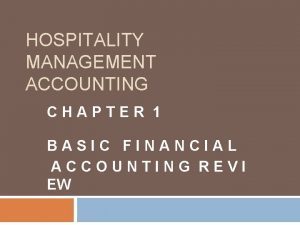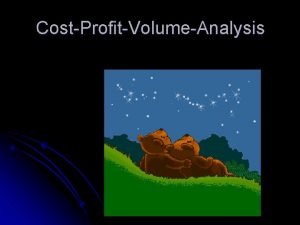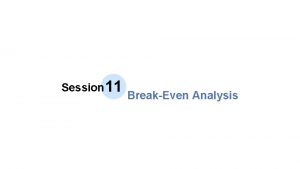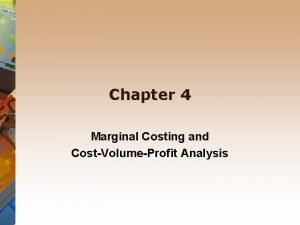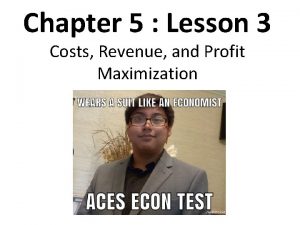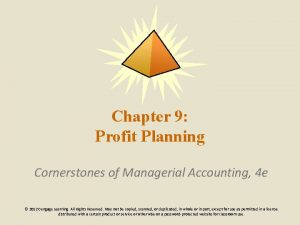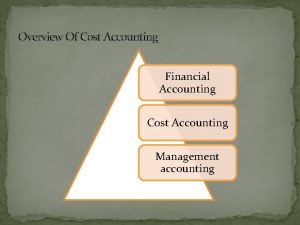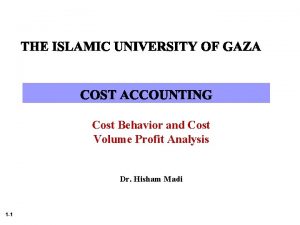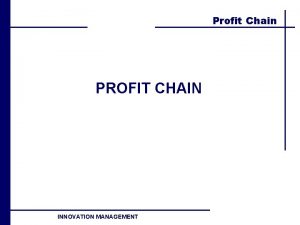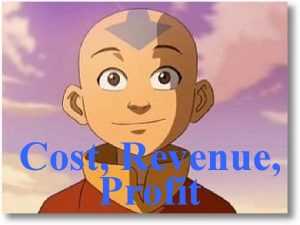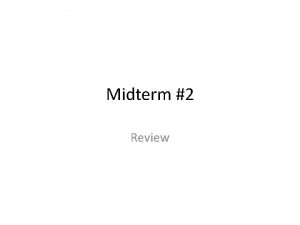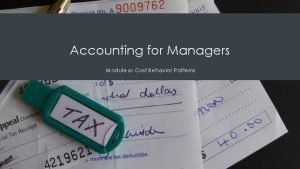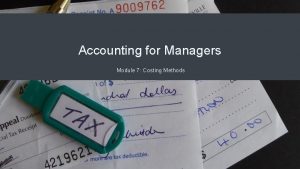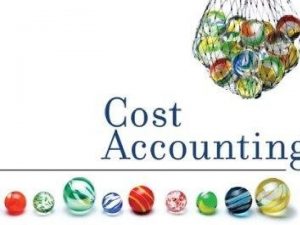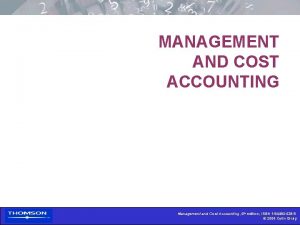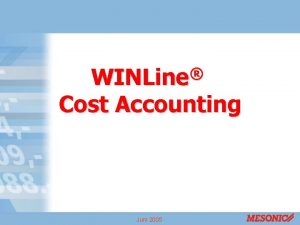Accounting for Managers Module 8 Cost Volume Profit





















- Slides: 21

Accounting for Managers Module 8: Cost Volume Profit Analysis

Cost-Volume-Profit Elements

Cost-Volume-Profit Analysis The cost-volume profit (CVP) analysis helps you to better understand the relationships between costs, volumes, and profits by focusing on how pricing products, activity volume, fixed and variable costs interact. Components of the CVP formula: 1. Profit 2. Fixed costs 3. Variable Costs Selling Price - Variable Costs - Fixed Costs = Profit

Contribution Margin Model Contribution margin is defined as the sales less the variable expenses. Sales - Variable Expenses = Contribution Margin

Net Operating Income The profit equation: Profit = Sales - Variable Expenses - Fixed Expenses Example: Monte Corporation sells their widgets for $10 each. The variable cost per widget is $4. Fixed expenses for the company are $400 per month. What would be Monte Corporation profit if they sold 200 units?

Contribution Margin Ratio • The contribution margin ratio is the difference between a company’s sales and variable costs, expressed as a percentage. • This ratio shows the amount of money available to cover fixed costs. (Sales - Variable Expenses)/Sales

Application of Cost-Volume-Profit Concepts

Cost-Volume-Profit Analysis and Decision Making • Even a slight change in costs can have a significant effect on the profitability of a company • As a manager, you may be responsible for making sure that costs are kept under control, or sales numbers are kept at a certain level to keep your company profitable

Statement of Fixed Cost and Sales Volume How can you adjust when your fixed costs increase? Raise the price of the product to compensate for increased expenses Source less expensive components of your product to lower variable costs Move to a less expensive facility Work on increasing the sales of the product • •

Statement of Variable Costs and Sales Volume What happens when your vendor increases the price of your supplies? Brainstorm some ways to compensate for the change in cost.

Statement of Fixed Cost, Selling Price, and Sales Volume Scenario: You sell widgets. Your competitor just released a new line of widgets for 20% less than your widget AND in several more colors. What problems could this cause? How would you compensate for this unseen setback? How would you create a statement to show your subsequent change in fixed cost, selling price, and sales volume? • • •

Statement of Variable Cost, Fixed Cost, and Sales Volume Scenario: A lower selling price at $8 per widget Higher fixed costs at $440 per month Higher variable costs at $5. 50 per widget • • • What would this look like on a new variable cost, fixed cost, and sales volume statement?

Break-Even Point Analysis

Break-Even Point • The break even point can be defined as the exact point where sales expenses = zero. • Two methods for discovering the break even point: • • Equation method Formula method

Target Profit Analysis • Target profit analysis helps us to know how much in dollar sales a company will need to reach a certain profit point • Example: Minnesota Kayak Company needs to sell 28 kayaks to break even. • • • Target Profit: $30, 000 $500 per kayak Variable costs per kayak: $225 Contribution margin per kayak: $275 Fixed costs/month: $7, 700 How many kayaks need to be sold to break even?

Margin of Safety • The margin of safety is the difference between actual sales and the break even point. • A higher margin of safety is good! Margin of safety = actual (or budgeted) sales required to break even

The Break-Even Point and the Sales Mix What happens if your company sells more than one product? How do you find your break even point and adjust the sales mix accordingly? As a manager, you may be asked to determine a product mix that is profitable for your company.

Cost-Volume-Profit and Cost Structure

Cost Structures • The percentage of sales that is related to fixed costs or variable costs is a component of cost structure. • Cost structure refers to the proportion of fixed and variable costs within an organization.

Operating Leverage Degree of operating leverage = contribution margin/net operating income % change in operating income = degree of operating income x % change in sales

Quick Review • Components of CVP • • • Profit Fixed Costs Variable Costs • How can CVP impact your decision making as a manager? • What is the break even point? Why is it important?
 Cost structure refers to the relative proportion of
Cost structure refers to the relative proportion of Normal profit vs economic profit
Normal profit vs economic profit Economic profit vs accounting profit
Economic profit vs accounting profit Cvp assumptions
Cvp assumptions Variable cost per unit formula
Variable cost per unit formula Basic assumptions of cvp analysis
Basic assumptions of cvp analysis Unit contribution margin equation
Unit contribution margin equation Cost volume profit analysis graph
Cost volume profit analysis graph Objectives of cvp analysis
Objectives of cvp analysis Post acquisition profit is which profit
Post acquisition profit is which profit Financial accounting chapter 1
Financial accounting chapter 1 Ucla general accounting fund managers
Ucla general accounting fund managers Module 53 featured worksheet profit maximization
Module 53 featured worksheet profit maximization Profit volume graph
Profit volume graph Session break even
Session break even Profit volume chart example
Profit volume chart example Cost revenue and profit maximization guided reading
Cost revenue and profit maximization guided reading Profit function from cost and revenue
Profit function from cost and revenue Profit planning managerial accounting
Profit planning managerial accounting Accounting for not for profit organisation notes
Accounting for not for profit organisation notes What is a departmental account
What is a departmental account C device module module 1
C device module module 1

